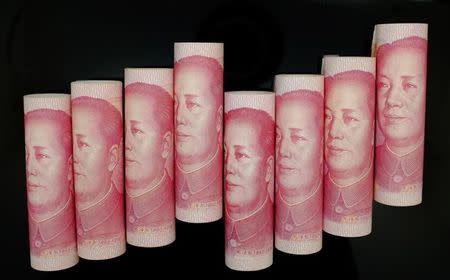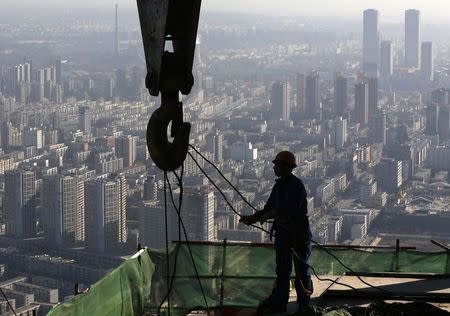Cooling China GDP growth likely to raise heat on policymakers
By Kevin Yao BEIJING (Reuters) - China is expected to post its weakest growth since the global financial crisis in the third quarter as a property downturn weighs on manufacturing and investment, raising the heat on Beijing to unveil more stimulus measures. Data on Tuesday is expected to show the world's second-largest economy expanded 7.2 percent in the September quarter from a year earlier, slowing markedly from 7.5 percent in the previous quarter, a Reuters poll showed. That would be its weakest performance since early 2009, when the growth rate tumbled to 6.6 percent and a collapse in world trade threw tens of millions of Chinese out of work. The market believes Communist Party leaders will tolerate a gradual slowdown as long as there are no signs of a potentially destabilising jump in unemployment, but anything weaker would fuel speculation of major stimulus measures such as an interest rate cut. "We expect weak Q3 data as the economy still faces relatively big downward pressures, but we have seen some positive signs from exports, power production and bank lending in September," said Tang Jianwei, senior economist at Bank of Communications in Shanghai. Premier Li Keqiang has said growth slightly below the official target of 7.5 percent this year was fine as long as the job market remained stable, saying the government accepted activity would slow as it tries to reform the economy. Annual growth slowed to 7.4 percent in the first quarter, before a series of stimulus steps, including infrastructure investments and cuts in the reserve requirement ratio (RRR) for smaller banks, lifted it briefly in the June quarter. While the leadership has offered a steady stream of aid to more vulnerable sectors of the economy, they have ruled out massive stimulus as China is still struggling to deal with a mountain of local government debt, the hangover from 4 trillion yuan (402 billion pounds) in spending rolled out in 2008/09 to cushion the impact of the global crisis. Similarly, the central bank has resisted calls to cut interest rates or RRR for all banks, while trying to coax increasingly risk-averse banks to continue lending and keep the financial system flush with cash to avert any damaging spikes in borrowing costs. In its latest move, sources said late last week that it was set to inject about 200 billion yuan of liquidity into some banks. "Further relaxation of credit supply through increased base money supply and relaxation of loan quotas could help, though we do not expect a RRR cut soon unless there are persistent large FX outflows," Tao Wang, China economist at UBS, said in a note. "We also expect a wholesale cut in the benchmark lending rate by the end of 2014 or early 2015 to help more effectively lower borrowing costs and boost businesses' cash flow." Authorities may resort to bolder and broader measures if quarterly growth slips below 7 percent, government economists at top think tanks involved in policy discussions said. Much will depend on whether recent government steps to relax lending rules for home buyers can stem house price declines, which have spread to a record number of cities. The resulting slump in new construction has dashed demand for everything from glass and furniture to cement and steel. MONTHLY DATA Beijing will also release some September activity data on Tuesday, which could give investors clues on how much economic momentum will be carried into the fourth quarter of the year. Factory output is forecast to have grown an annual 7.5 percent in September, quickening from August's 6.9 percent, a near six-year low. Retail sales, a gauge of consumption, likely grew 11.8 percent, largely steady from August. Investment figures, however, are likely to prove more worrying. Growth in fixed-asset investment is seen easing slightly to 16.3 percent for the January to September period, from 16.5 percent in the first eight months of the year. Other investment data will show the extent of the slowdown in the property sector, which accounts for about 15 percent of GDP. Earlier data for September painted a mixed picture, with bank lending quickening and exports and imports beating expectations, but consumer inflation slipping to its lowest in nearly 5 years, pointing to broader weakness in the economy. (Reporting by Kevin Yao; Editing by John Mair & Kim Coghill)

 Yahoo News
Yahoo News 


